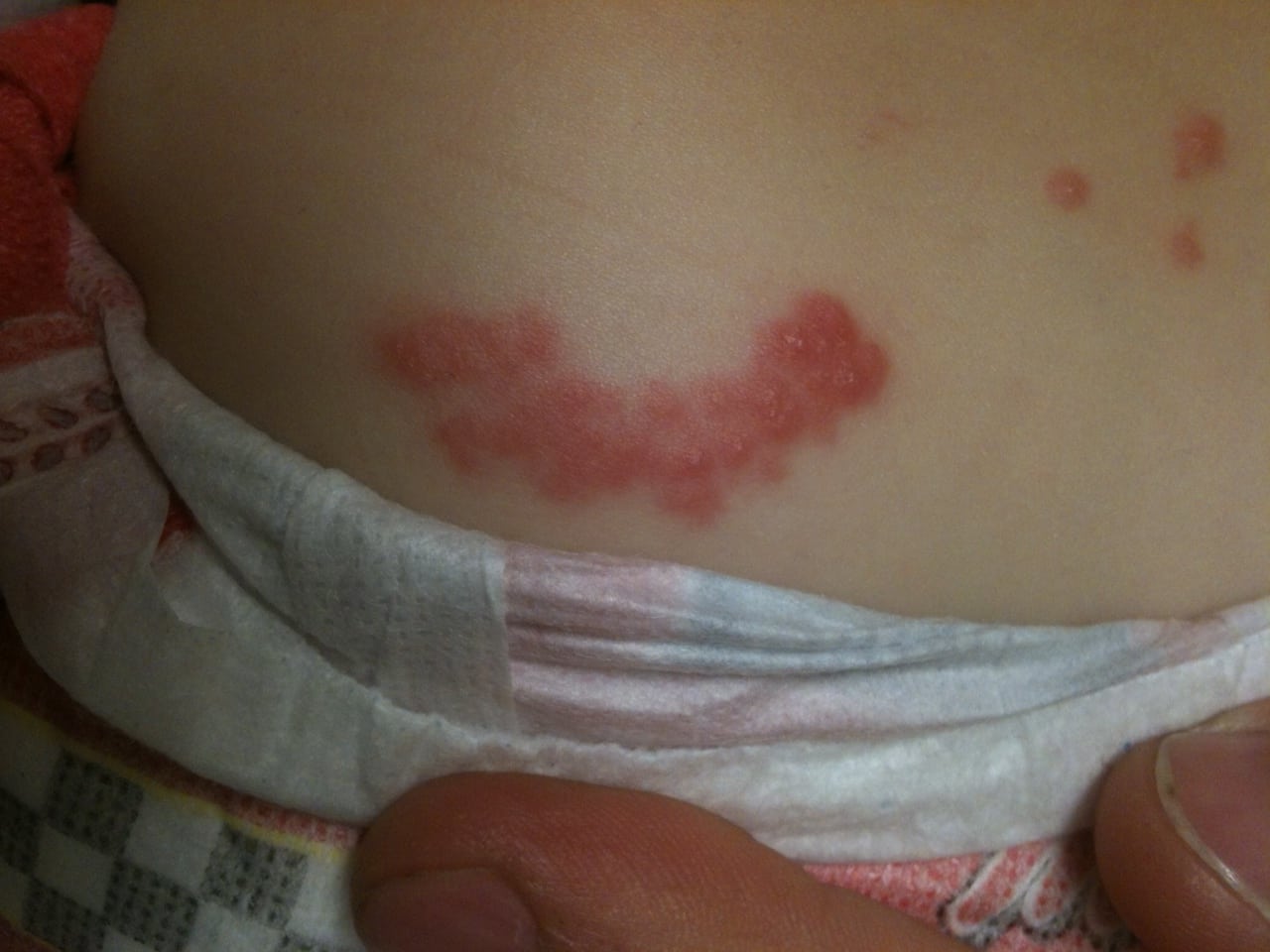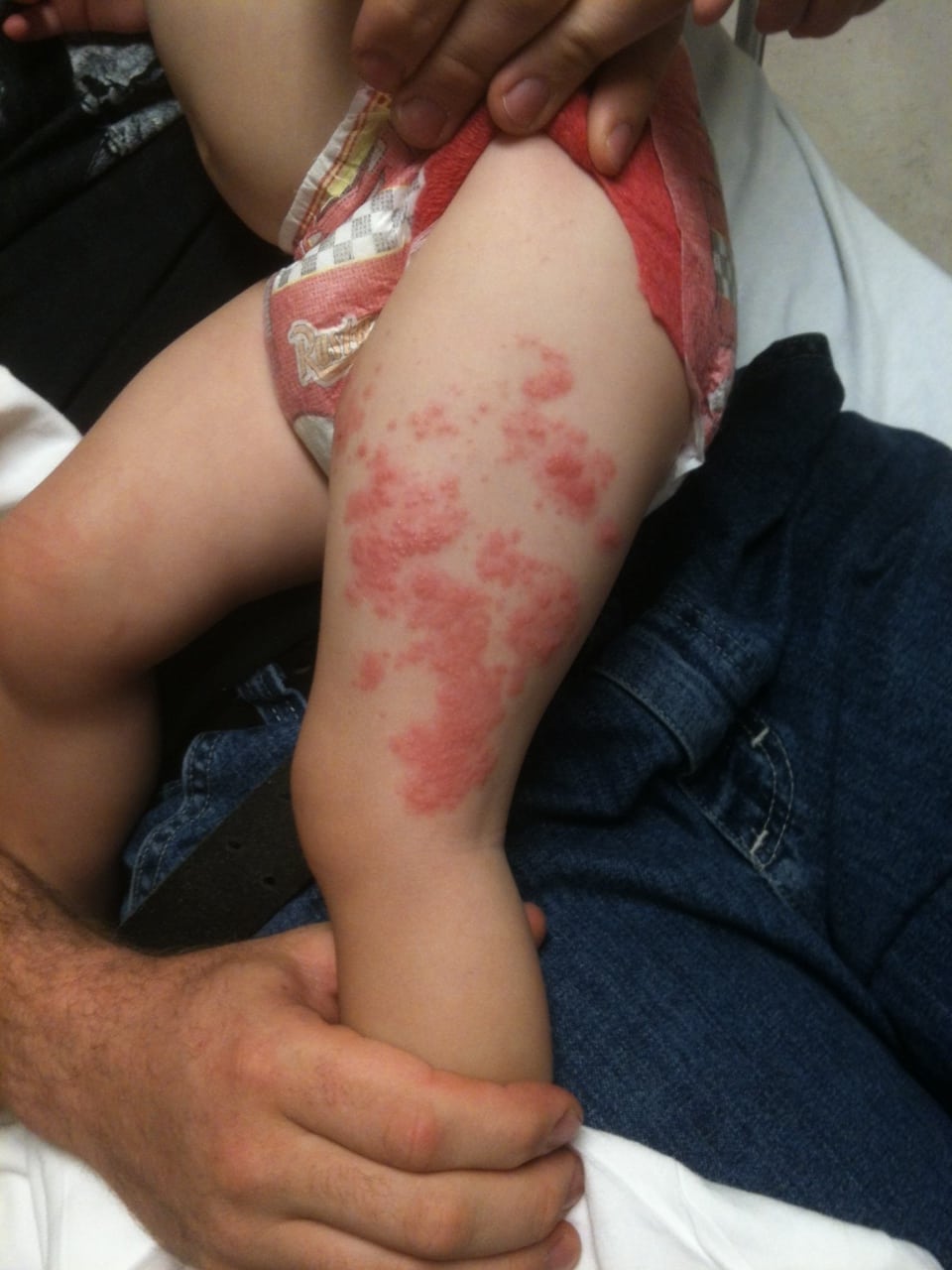| Author | Affiliation |
|---|---|
| Jared Sutton, MD | Madigan Army Center, Department of Emergency Medicine, Tacoma, Washington |
| Ryan Walsh, MD | Madigan Army Center, Department of Emergency Medicine, Tacoma, Washington |
| Jillian Franklin, MD | Madigan Army Center, Department of Emergency Medicine, Tacoma, Washington |
ABSTRACT
A 2 year old fully immunized male with no personal history of chicken pox presented to the emergency department with a chief complaint of a rash for one week after returning from a hiking trip in a remote island in Canada. After initially being diagnosed with contact dermatitis, a diagnosis of herpes zoster was made by confirmatory viral polymerase chain reaction testing. The purpose of this case report is to examine the literature for the incidence and etiology of shingles in children without a prior history of a primary varicella rash outbreak.
CASE REPORT
A 2 year old male presented with chief complaint of a rash on his left thigh and left lower back for 7 days. The mother of the child initially noted the rash on the child’s left thigh after returning from a one week camping trip on a remote island in Canada. While the parents had gone hiking in the woods, the child was in day care during their trips and the parents said there was no point at which the child would have been exposed to any plants or other environmental exposures. After two days the mother took the child to an acute care clinic where the diagnosis of suspected contact dermatitis was made. The patient was treated with antihistamines and topical steroids. Over five days the rash progressed to involve the left lower back and appeared to spread outward from the initial area on the left thigh. It was at this time the patient presented to our emergency department for evaluation. The birth history was non-contributory. The patient was previously healthy, circumcised, and fully immunized through the age of two to include varicella. The patient was never exposed to chicken pox. The patient did not exhibit any signs of illness with the exception of a fever to 101.0°F orally the day prior to presentation. Upon further questioning, the father of the patient recovered from shingles the previous week but was currently asymptomatic. The child had normal vitals on physical examination. The rash was maculopapular with small vesicular lesions on the left anterolateral thigh and left lower lumbar back in the L3 dermatome that blanched to palpation. There were two areas of coalescing papules located at the right paraspinous region of the mid-lumbar spine. There were no oral or anogenital lesions. The palms and soles were not involved. The rest of the examination was unremarkable.

Figure 1
Classic dermatomal distribution of vesicular rash extending from the left lumbar back to the left anterolateral thigh.

Figure 2
Classic dermatomal distribution of vesicular rash extending from the left lumbar back to the left anterolateral thigh.
Pediatrics were consulted for evaluation of the rash which was suspected to be herpes zoster. After admission to the pediatrics ward, viral deoxyribonucleic acid (DNA) polymerase chain reaction (PCR) studies were obtained via blood samples of the child, which were positive for varicella zoster DNA.
DISCUSSION
Initial herpes zoster infection in previously healthy children has been documented in the literature as a rare disease and to our knowledge, this is the first case reported in the emergency medicine literature. According to Leung et al1, the incidence of zoster after primary exposure to varicella appears to be higher than in the vaccinated population. The incidence of herpes zoster is 14 cases per 100,000 person years among vaccine recipients and 20 to 63 (cases per 100,000 person years) among those with a natural varicella infection. A child, without experiencing a known primary outbreak of varicella zoster (chicken pox), may have his or her initial manifestation of the disease as herpes zoster (shingles). Leung et al1 suggest that 2% of children exposed to varicella in utero may develop a subclinical chicken pox and are subsequently predisposed to a primary skin outbreak occurring in the form of herpes zoster. This is one of the mechanisms by which it is possible to see a child with a dermatomal rash without a known history of chicken pox. The rash may also develop in the setting of vaccination. Liang et al2 reported a case of a child vaccinated for chicken pox who then developed a dermatomal rash four months later. This patient was a 19 month old previously healthy child that developed a dermatomal rash in her right upper extremity at the site of her prior vaccination at 15 months. PCR testing revealed the Oka vaccine strain virus from her right arm culture.2 On another account, Kohl et al3 presented a case report of a 6 year old boy without a known history of varicella exposure that presented with a wild type virus dermatomal rash. It was unknown whether or not the mother had varicella during her pregnancy with him. He was vaccinated in his right arm. He subsequently developed a dermatomal zoster rash 12 days later. This rash was subsequently confirmed to be wild type virus by viral PCR rather than vaccine type as anticipated.3 Viral PCR and restriction fragment length polymorphism are currently used to verify the source as either vaccine DNA or wild type varicella.1 Considering this, a number of mechanisms exist by which a child may present with a dermatomal rash without having any clear history of exposure to chicken pox.
After confirming the diagnosis of herpes zoster, the treatment depends on a variety of factors including the age of the patient, location of the rash, and whether or not the host is immunocompromised. Cohen4 states that in adult patients, all immunocompromised and select immunocompetent individuals should receive antiviral treatment. Immunocompetent adult patients that should receive treatment include, but are not limited to, those with an age greater than 50, intractable pain, severe rash, and involvement of the face or eye.4 In children, treatment caveats are similar. Antiviral treatment of herpes zoster in immunocompetent children should focus primarily on children with zoster ophthalmicus as well as children with a moderate to severe rash at onset.5 The underlying goal of treatment with antivirals in all age groups should be the improvement of pain and healing of lesions, as current literature suggests that antivirals do not significantly lower the incidence of post herpetic neuralgia.4 Of note, the incidence of post herpetic neuralgia is 0% in patients 0 to 29 years old and 34% in those over 80. Therefore, treating a pediatric patient with antivirals for the sole purpose of preventing post herpetic neuralgia would not likely confer benefit.5
If antiviral treatment is indicated, the treatments of choice for adults are the Food and Drug Administration (F.D.A.) approved medications acyclovir, famciclovir, and valacyclovir. Acyclovir remains the only F.D.A. approved medication for herpes zoster in children under 18 years old.5 No matter the antiviral chosen, the goal to treat zoster within 72 hours of the onset of the rash is commonly mentioned. Some experts suggest that treating beyond this 72 hour window if the rash or disease continues to progress would be prudent, as it likely still confers benefit. The course of antiviral treatment should usually be 7 days.4
Other modalities used for treatment of zoster related pain for adults include opioids, lidocaine patches, gabapentin, and glucocorticoids. Glucocorticoid therapy remains in question, though some trials demonstrate benefits in pain and healing. Glucocorticoids also have not been shown to decrease the incidence of post herpetic neuralgia.4 For most pediatric patients, ibuprofen provides adequate relief of acute zoster related pain, although opioid medications like codeine should be considered for severe pain.5
The patient in this case report was discharged after starting on acyclovir and an uncomplicated overnight stay in the hospital. No glucocorticoids or novel treatments for zoster were prescribed.
The reason for the dermatomal rash on his thigh was not confirmed to be either wild or vaccine related, but this case supports the need for a thorough history and physical examination as well as retaining a high index of suspicion for any dermatologic disorders considered in the differential diagnosis.
Footnotes
Full text available through open access at http://escholarship.org/uc/uciem_westjem
Address for Correspondence: Jared Sutton, MD. Madigan Army Center, Department of Emergency Medicine, 9040 Jackson Ave., Tacoma, WA 98431. Email: jasutton41@gmail.com. 7 / 2014; 15:372 – 374
Submission history: Revision received August 22, 2013; Submitted January 1, 2014; Accepted January 27, 2014
Conflicts of Interest: By the WestJEM article submission agreement, all authors are required to disclose all affiliations, funding sources and financial or management relationships that could be perceived as potential sources of bias. The authors disclose none. The paper is the opinions of the authors and by no means reflects either the opinions or interests of the United States Army, Madigan Army Medical Center, the Department of Defense, or the United States Government.
REFERENCES
1 Leung AKC, Robson WLM, Leong AG Herpes zoster in childhood. J Pediatr Health Care. 2006; 20:300-303
2 Liang MG, Heidelberg KA, Jacobson RM Herpes zoster after varicella immunization. J Am Acad Dermato. ; 38:761-763
3 Kohl S, Rapp J, La Russa P Natural varicella-zoster virus reactivation shortly after varicella immunization in a child. Pediatr Infect Dis J. 1999; 18:1112-1113
4 Cohen J Herpes zoster. N Engl J Med. 2013; 369:255-263
5 Feder H, Hoss D Herpes zoster in otherwise healthy children. Pediatr Infec Dis J. 2004; 23:451-457


